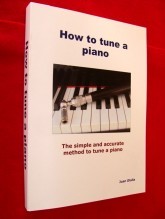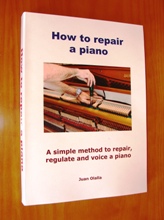The makeshift piano tuning tutorial. Solve the problem of a badly out of tune piano, at least while you call the tuner or even better till you learn to tune yourself the professional way. The only thing you need is a tuning lever and two rubber wedges.
Disclaimer: What follows is a general information tutorial on how to tune a piano in an emergency situation. In no way this should be considered as an accurate and professional work. To know more about this topic and view the full protocol, please refer to ebook “How to tune a piano”, Chapter VI and VII.
Although this can only be consider as a rough-and ready kind of piano tuning, it can improve quite a big deal the sound of an out of tune piano. In this “unorthodox” way of tuning your own piano you will not have to set the temperament, just take care of the unisons. Learning to do this basic piano tuning is an excelent exercise and prepare you to undertake the standard method for tuning a piano like a pro.
Reasonably often we encounter pianos that even they are not “terribly” out of tune, have a few keys that stand out by its sound offensively lousy. Every time we press any of those keys the effect “out of tune” is particularly relevant.
The problem is that the frequencies or pitches of the strings that form the bichord or threechord for that tone don’t match one another and therefore that very unpleasant out of tune effect. Some particular keys just yells and meows like a cat.
The threechord (also call unison) are three strings that correspond to one note or key of the piano. Approximately two thirds of a piano keyboard (the upper section) are threechords). These unisons should be tune at exactly the same pitch. That means when you strike a note perfectly in tune, it shouldn’t produce any pulses or beats, and the three strings that correspond to that key should sound as a single one.
On the contrary, when those three strings that correspond to an unison are not tuned at exactly the same pitch, produces that shrill and unpleasant sound we all know too well. To mend this nuisance is relatively simple. The modus operandi or at least the way I have always done it is as follows:
Step number 1
Remove the piano lid so that you can see the action (sorry for describing the very obvious, but you never know who is reading). Now play the key that you want to tune (for example middle C) and try to identify the threechord (or bichord) that corresponds to that particular key.
Step number 2
In this step you will select one of the three string to use as a reference to tune the other two. To do this, press the sustain pedal in order to lift the dampers so that the strings are unmuted, then play one by one each string with the nail or a plectrum while also playing the same key on the upper and lower octave. The idea is to decide which one of the three strings is better in tune and therefore the one to use as a reference.
Step number 3
If in doubt, chouse the string in the middle. Ok, just imagine you have selected the center string as your reference. Now using one rubber wedge or anything can serve for the same purpose, insert it so that you mute the left string. If we do this right, when we strike the key it will sound only the center and right string, not the left one as it is muted.
Step number 4
Follow the right string upward till you find its pin and put the tuning lever there. Now play middle C (the key that we are tuning) and listen carefully, you should hear a kind of “wou wou“ sound changing in intensity, this we call beats or pulses. Our objective is to remove this pulse, so that the two strings are beatless and sound as a single one.
Step number 5
Grab the tuning hammer firmly and twist it gradually counterclockwise (just a tiny fraction) noticing how the beats go faster till eventually disappear. If you twist the tuning hammer too far you will not hear any beats and the two string will sound as two different tones. We only hear beats when the pitch of the two string that we are tuning are quite close.
Twist the hammer clockwise and you will start hearing beats again. Gradually twist the tuning lever noticing how the pulses slow down till they eventually disappear, then the string is tuned. At this stage you will probably have to manipulate and adjust the tuning lever clockwise and counterclockwise by fractions in order to set the pin solidly. As we said before, the goal is to eliminate all audible beats
Step number 6
Now that we have got the right string of our unison in tuned, you will tune the left one. Using the rubber wedge mute the right string, so that when you strike the key, only sounds the center and the left string. Put the tuning hammer on the pin for the left string and proceed as you did before till there are no beats
Step number 7
Remove the tuning lever and play the key. It should be in tune, and the three strings of the unison all at exactly the same pitch. Middle C should sound now neat and clear, without any of the previous unpleasant beats. If still not quite right, go back to step 4 and do it all over again. Repeat the same process for any other key on the piano which stands out for its particularly lousy sound.
Very important:
Make sure that you got the right pin, otherwise you could very easily break the string.
Check and double check before you start twisting the pin. Listen carefully. Remember, what we try to hear are pulses or beats not musical notes. Grab the tuning lever firmly and twist it with extreme care, just a fraction of movement is enough to alter the pitch. Don’t forget to strike the keys solidly, that’s the way to set the strings so that the tuning will last longer.
Doing this for the first time might seems difficult but it is not really, just take a bit of practice. I think it is harder to explain than to do. Good luck.
© copyright Juan Olalla 2010
What do you think about this article, has it been helpful? You are welcome to leave a reply. Your opinion and/or suggestions are highly appreciated. Thanks







Speak Your Mind